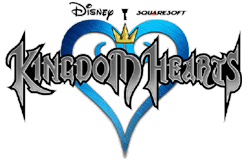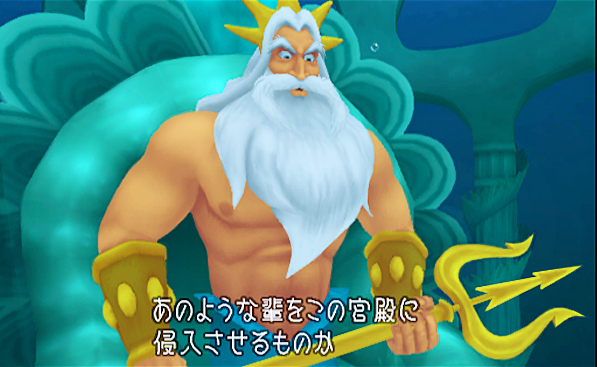|
|

|
PLATFORM
|
PS2
|
BATTLE SYSTEM
|

|
INTERACTION
|

|
ORIGINALITY
|

|
STORY
|

|
MUSIC & SOUND
|

|
VISUALS
|

|
CHALLENGE
|
Adjustable
|
COMPLETION TIME
|
20-40 Hours
|
|
OVERALL

|
+ Fun battle system.
+ Solid visuals.
- Platform-laden areas can affect combat.
- Infantile plot.
|
Click here for scoring definitions
|
|
|
In 2001, Square announced the unthinkable: that they would be jointly producing an RPG with Disney. Many hailed this union; after all, this was a union of Square, maker of many superb RPGs, and Disney, maker of many superb animated movies. Others damned this union; after all, Disney had no experience whatsoever in producing RPGs, and had then gone into something of a downward spiral, as dozens of direct-to-video sequels seemed to indicate. Nonetheless, the first result of Square and Disney's union saw its release around the world the following year. Did their joint venture work out?
After a flashy opening FMV where the protagonist, Sora, for some reason, dreams of drowning in water, and a subsequent interactive sequence determining his stat growth throughout the game, he awakens in his homeland, Destiny Islands, where his lives with his love interest Kairi, younger versions of Final Fantasy characters Tidus, Wakka, and Selphie, and while Rikku doesn't show up, the writers took her name, shaved off a k, and gave it to Sora's other male friend and rival. After a day of gathering supplies to escape Destiny Islands, mysterious beings known as the Heartless invade the archipelago, with Sora soon finding himself in Traverse Town, where he meets with Donald and Goofy, looking for King Mickey, missing in action.
After Sora joins forces with Disney's intellectual property, they'll frequently encounter more Heartless that randomly appear out of nowhere on various Disney-themed worlds they traverse. While the A.I. controls Sora's allies (or a world-exclusive character that the player can exchange at save points in that world), the player manually controls Sora himself in real-time combat. A menu dictates what commands he can use, the most common of which is Attack, making him swing his Keyblade. Frequently selecting the Attack command will cause Sora to string together attacks in a combo against the currently-targeted enemy.
 Sora discovers the horrible truth
Sora discovers the horrible truth
|
|
Sora also gains various magic spells that the player can execute either by navigating the battle menu (with the action of battle not pausing during menu navigation) and selecting the spell or assigning three spells to button shortcuts the player can access more easily. Sora, furthermore, can equip a certain number of consumable items that the player can navigate the battle menu to use, but since the action of battle, as mentioned, doesn't stop while the player does so, using healing magic instead is usually a better option when his HP is low. Sora can recover his MP either with ethers or repeated attacks against the enemy.
Sora's allies also have their own HP and MP, not to mention sets of items the players can equip to them in the game menus (which the player can't access during battle), and while the player can't manually control them, they do often do a decent job in keeping Sora healed when his HP drops low, and if they themselves lose all HP, the player can simply bring them back into action by using a normal HP-healing item on them. The player, moreover, can adjust their A.I. settings, not to mention everyone's equipment, in the game menus.
Each character also has a number of active and passive skills that the player can equip in the menus, with AP (which occasionally increases after leveling) dictating how many they can equip. These skills have effects such as giving Sora additional attacks when he strings combos together, recovering some MP when attacked, and giving him an MP-consuming skill in the fourth battle menu slot. Sora can also acquire several summon spells that temporarily take the place of his allies, with each being usable once per battle.
 "Rule 11: DON'T MAKE FUN OF MY FLAMING HEAD!"
"Rule 11: DON'T MAKE FUN OF MY FLAMING HEAD!"
|
|
Though the battle system is in essence simple, hacking away at the Heartless can actually be somewhat fun, and the ability to "Continue" after death from the beginning of a room gives some room for occasional mistakes. Since Sora constantly bounces around while attacking, however, it is possible to accidentally fall from platforms in large chambers and have to retrace steps taken there. Many boss fights don't require a great deal of strategy, either, aside from hacking away at them and healing, and navigating the battle menu to use items in the heat of battle can be tedious at times, making healing magic preferable. Still, the battle system is decently put together.
The menus in Kingdom Hearts aren't terribly troublesome, and the player will generally have a good idea on how to advance. Going from world to world requires use of the Gummi Ship, with space shooter-esque sequences between worlds. It is possible to customize the Gummi Ship and create new ones with help from blueprints (although the interface for selecting specific blocks and moving them around is unintuitive), but odds are players will spend more time looking for the necessary parts for them than actually using them, with the player ultimately being able to skip Gummi Ship flight among visited worlds. As mentioned, moreover, the design of some dungeons, coupled with Sora bouncing around during combat, can lead to some accidental falls off platforms and backtracking. All in all, interaction is decent but not perfect.
Given its fusion of various worlds and characters from Disney's movies and some gameplay mechanisms from the Final Fantasy games (with the skill-equip system resembling that in the ninth installment), Kingdom Hearts leaves something to desire in the creativity department, although the action elements and overall execution of the battle system do feel somewhat unique, and ultimately, even this crossover RPG has in some instances a distinct feel.
 "You know nothing of my work!"
"You know nothing of my work!"
|
|
It's always difficult to judge the artistic merit of crossover storylines, and since Kingdom Hearts is generally intended for younger audiences, older gamers will certainly find the plot to be something of a turnoff. The story itself really isn't all that well-executed, with tired elements such as rivalry between best friends, the themes of the power of love and friendship, and so forth. Sora and company's goal of looking for King Mickey and Kairi, too, is never terribly urgent, with most of the plot revolving around rehashed versions of various Disney films with the Heartless worked in somehow. Some parts of the plot, such as backstory for the Heartless in the form of Ansem Reports, are half-decent, but other things such as occasional holes and a vague ending don't work to its benefit, and ultimately, story is the game's nadir.
The music and sound, however, fare better. Yoko Shimomura's music fits the game's various environs and scenes, but definitely isn't her strongest work or great enough to make the game soundtrack worth a purchase. The voice acting is definitely above average, with most of the Disney characters present sounding as they should, and Square's characters, not to mention the original characters, sounding decent, as well. Overall, the music and sound don't detract from the game, although the former could have certainly been better.
Kingdom Hearts, however, definitely looks better than it sounds. The visual style is neither fully realistic nor fully cartoony, with characters and the scenery within the various Disney-themed worlds being nice and colorful and photorealistic FMVs opening and ending the game, looking nice as always. There are some minor imperfections in certain parts of the scenery, such as flora, when it's close to the screen, and the Gummi Ship sequences look somewhat primitive, but otherwise, the graphics are a high point.
Finally, a straightforward playthrough of the game can take as little as twenty hours, although extras such as hidden bosses, finding all Trinity symbols, mini-games, and so forth, can easily boost playing time. All in all, Kingdom Hearts is a decent start to Square and Disney's RPG series, with a simple but fun battle system and solid visuals standing out the most. The story is somewhat infantile, and thus, it's really not the kind of title most gamers will feel comfortable sharing with friends and family, but it still holds out reasonably well, as superb commercial success and several sequels would definitely indicate.
Review Archives
|









